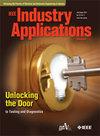过程环路组件故障诊断的数据驱动框架
IF 4.5
2区 工程技术
Q2 ENGINEERING, ELECTRICAL & ELECTRONIC
引用次数: 0
摘要
石油、天然气、发电厂、制造工厂和相关行业的所有工业操作都是自动化的。为了高效、安全地进行作业,所有现场仪器都必须正常工作。许多事件,如机械故障、电气故障、设备老化、操作失误和缺乏维护的组件是导致工厂计划外停机的主要原因。由于各种仪器在不同的操作条件下工作,预防性维护技术是无效的。状态监测(CBM)技术需要振动和温度数据来诊断仪器的性能。CBM技术不是实时的,而且由于需要专家来诊断故障,成本很高。此外,现场仪器所需的自动化维修计划至今尚未进行试验和测试。提出了一种数据驱动框架,用于监控变送器、流压变换器和控制阀等过程回路部件的在线性能。如果正确诊断出故障类型,则可以采取纠正措施。控制阀和电流-压力转换器的实时数据被用于开发回归和分类模型。回归模型在电流-压力转换器和控制阀的校准中检测偏差。支持向量机分类模型已被开发用于识别诸如漏气、粘滞和定向干扰等故障。为了诊断流程循环组件的性能,数据驱动模型是有用的。SVM模型对控制阀的故障诊断准确率为97.73%。使用数据驱动模型比预防性维护和CBM技术更有效地维护过程循环组件。本文章由计算机程序翻译,如有差异,请以英文原文为准。
Data-Driven Framework for Fault Diagnosis of Process Loop Components
All industrial operations for oil, gas, power plants, manufacturing plants, and allied industries are automated. To run operations efficiently and safely, all field instruments must be working properly. Many events like mechanical failure, electrical failure, aging of equipment, operator errors, and lack of maintenance of components are leading causes of unscheduled downtime in the plant. Preventive maintenance techniques are not effective as a variety of instruments are working under different operating conditions. Condition Based Monitoring (CBM) techniques require vibration and temperature data to diagnose the performance of the instruments. CBM techniques are not real-time and are costly as an expert is required to diagnose the faults. Moreover the automated maintenance schedule required for field instruments has not been tried and tested till present. A data-driven framework is proposed to monitor the online performance of process loop components such as transmitters, current-to-pressure converter and control valve. If the type of fault is correctly diagnosed, corrective action can be taken. Real-time data for a control valve and a current-to-pressure converter has been used to develop regression and classification models. Regression models detect deviation in the calibration of a current-to-pressure converter and control valve. SVM Classification models have been developed to identify faults like air leakage, stiction, and disturbed orientation. To diagnose the performance of process loop components, data-driven models are useful. The SVM model shows 97.73% accuracy for fault diagnosis of the control valve. Process loop component maintenance is more effective using a data-driven model than preventive maintenance and CBM techniques.
求助全文
通过发布文献求助,成功后即可免费获取论文全文。
去求助
来源期刊

IEEE Transactions on Industry Applications
工程技术-工程:电子与电气
CiteScore
9.90
自引率
9.10%
发文量
747
审稿时长
3.3 months
期刊介绍:
The scope of the IEEE Transactions on Industry Applications includes all scope items of the IEEE Industry Applications Society, that is, the advancement of the theory and practice of electrical and electronic engineering in the development, design, manufacture, and application of electrical systems, apparatus, devices, and controls to the processes and equipment of industry and commerce; the promotion of safe, reliable, and economic installations; industry leadership in energy conservation and environmental, health, and safety issues; the creation of voluntary engineering standards and recommended practices; and the professional development of its membership.
 求助内容:
求助内容: 应助结果提醒方式:
应助结果提醒方式:


